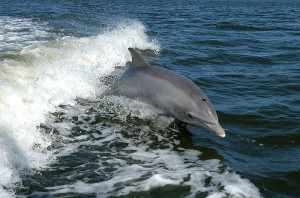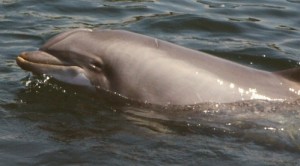Bottlenose Dolphin
 The bottlenose dolphins are one of the most commonly known dolphins, of the oceanic dolphin family Delphinidae. Recent studies have shown that there may be two species of bottlenose dolphins, the Common Bottlenose Dolohin (Tursiops truncatus) and the Indo-Pacific Bottlenose Dolphin (Tursiops aduncus), instead of one species as originally thought.
The bottlenose dolphins are one of the most commonly known dolphins, of the oceanic dolphin family Delphinidae. Recent studies have shown that there may be two species of bottlenose dolphins, the Common Bottlenose Dolohin (Tursiops truncatus) and the Indo-Pacific Bottlenose Dolphin (Tursiops aduncus), instead of one species as originally thought.
These dolphins inhabit the warm waters of many oceans.
Interestingly these dolphins have been known to breed with other dolphin species, both in the wild and in captivity, particularly with the Risso’s Dolphin.
The most well know hybrid is the ‘Wholphin’, the False Killer Whale – Bottlenose dolphin. False Killer Whales (Pseudorca crassidens) are actually, taxonomically speaking, dolphins. Wholphins are the rare offspring of a male false killer whale and a female bottle nosed dolphin. There are many reports of wholphins living in the wild, but only two live in captivity (both in Seal Life Park in Haiwaii). Surprisingly, wholphins have also proven to be fertile, after the female wholphin, called Kekaimalu, in captivity gave birth to a wholphin calf. This calf however died after a couple of days. Kekaimalu has since given birth to two more calves, the first lived up to nine years, and the second, who was sired by a male bottlenose dolphin, is still alive. This third calf was reported as being the size of a 1 year old bottlenose dolphin at only a couple of months of age.
Bottlenose dolphins range in colour from a light grey to dark grey, and almost all of them have a white underside. In adulthood they can reach a length of two to four metres and weigh 150 – 659 kg; the males are considerably heavier than the females.
 Bottlenose dolphins generally live in groups called ‘pods’, consisting of about 10-30 individuals, however some groups can have as little as one dolphin or as many as 1,000 bottlenosed dolphins.
Bottlenose dolphins generally live in groups called ‘pods’, consisting of about 10-30 individuals, however some groups can have as little as one dolphin or as many as 1,000 bottlenosed dolphins.
Dolphins have a very complex system of communication between each other, made up through burst pulsed sounds, whistles and body language (jumping out of the water, slapping of tails e.t.c). These sounds have been researched extensively by several groups of researchers, and have proven that these communication methods are vital for the dolphins’ social life.
During mating seasons males may fight each other for females and round up their own herds of females, which they will be very protective over. The gestation period is 12 months for bottlenose dolphins; birth can happen at any time of the year. Females are able give birth to their own young from 4 – 13 years of age.
 November 29, 2010
·
November 29, 2010
·  Maddia (Admin) ·
Maddia (Admin) ·  Comments Closed
Comments Closed
 Tags: bottlenose dolphin, common bottlenose dolphin, indo-pacific bottlenose dolphin · Posted in: Dolphins
Tags: bottlenose dolphin, common bottlenose dolphin, indo-pacific bottlenose dolphin · Posted in: Dolphins


